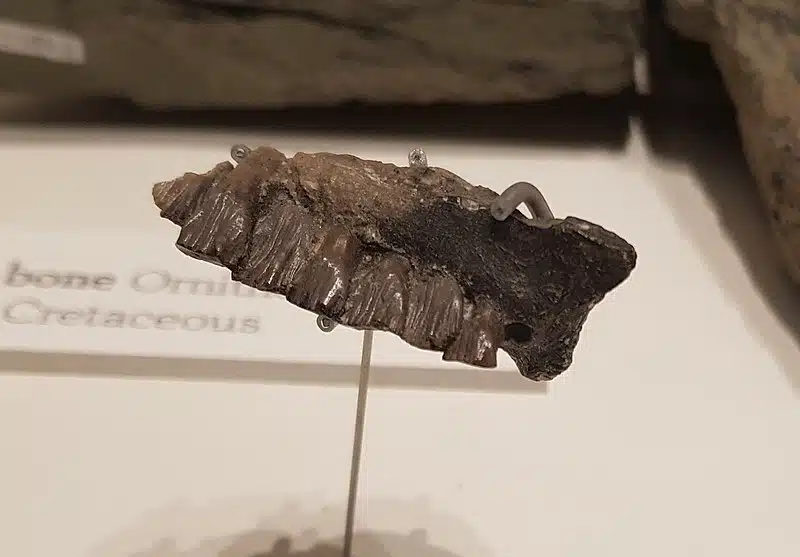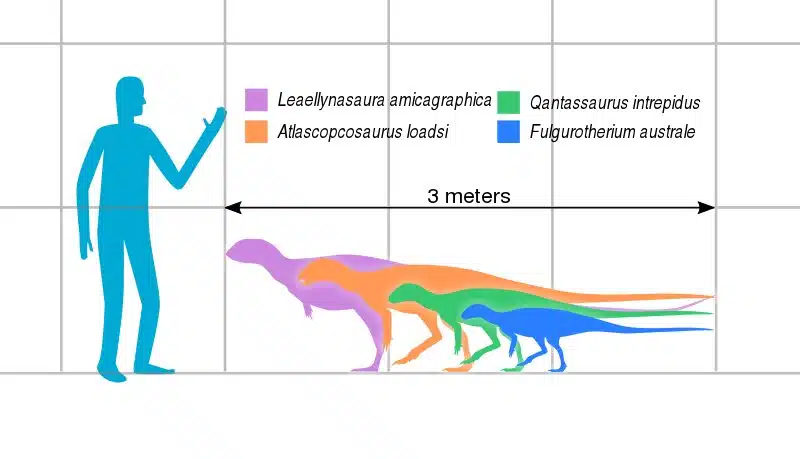Welcome to a journey back in time, to an era when the Earth was inhabited by creatures so immense and so different from anything we know today that they almost defy imagination. Our focus today is on one such creature–a dinosaur known as the Atlascopcosaurus.
This dinosaur, whose name may be a bit of a tongue twister, is a fascinating creature from the Early Cretaceous period. Its story is a testament to the wonders of paleontology and the secrets that the Earth still holds for us to discover.
Atlascopcosaurus Key Facts
| Keyword | Fact |
|---|---|
| Atlascopcosaurus pronunciation | Atlass-KOP-KO-sore-us |
| Meaning of name | Atlas Copco Lizard |
| Group | Ornithopod |
| Type Species | Atlascopcosaurus loadsi |
| Diet | Herbivore |
| When it Lived | 122.46 to 109.0 MYA |
| Period | Early Cretaceous |
| Epoch | Late/Upper Aptian to Early/Lower Albian |
| Length | 6.5 to 10.0 ft |
| Height | 3.0 ft |
| Weight | 250-280 lbs |
| Mobility | Moved on two legs |
| First Discovery | 1984 by Tom Rich and colleagues |
| Location of first find | Victoria, Australia |
| First Described by | 1989 by Tom Rich and Patricia Vickers-Rich |
| Holotype | NMV P166409 |
Atlascopcosaurus Origins, Taxonomy and Timeline

Atlascopcosaurus, whose name translates to “Atlas Copco Lizard,” has a rather unique etymology. The name is derived from the Australian company, Atlas Copco, which provided the equipment used in the dig that uncovered this dinosaur.
In terms of taxonomy, it belongs to the Ornithopoda group, specifically the Hypsilophodontidae family. The genus has one species, Atlascopcosaurus loadsi. This classification places the dinosaur among the herbivorous dinosaurs that are known for their bird-like stance and bipedal movement. This dinosaur lived during the Early Cretaceous period, specifically from the Late/Upper Aptian to the top of the Early/Lower Albian.
Listen to Pronunciation
Discovery & Fossil Evidence
It was first discovered in 1984 in Victoria, Australia by Tom Rich and Patricia Vickers-Rich. This discovery was a significant contribution to our understanding of the dinosaur fauna of Australia during the Early Cretaceous period. The holotype, or the specimen used to describe the species, is catalogued as NMV P166409.

The fossil evidence is limited but valuable. The holotype consists of partial cranial and postcranial remains, providing crucial insights into the dinosaur’s physical characteristics and possible behaviors. The preservation of the fossils is relatively good, allowing for detailed study and analysis.
While it is not as well-known or extensively studied as some other dinosaurs, the available fossil evidence has contributed significantly to our understanding of this unique creature and its place in the dinosaur world.
Atlascopcosaurus Size and Description
This was a bipedal dinosaur, like many of its Ornithopod relatives. This means it moved primarily on its two hind legs, using its forelimbs for balance and possibly for foraging. It was relatively small compared to many of its iguanodont relatives of the time.
Atlascopcosaurus was a small to medium-sized dinosaur with a body shape typical of the Ornithopods. It had a long, slender neck and a small head with a beak-like mouth for feeding on vegetation. Its vertebrae were robust to support a strong, flexible spine. The limbs were well-adapted for bipedal movement, with strong hind limbs and smaller, but functional, forelimbs. The tail of Atlascopcosaurus was long and likely used for balance during movement.
Size and Weight of Type Species

The exact size and weight are not well-documented due to the limited fossil evidence. However, based on comparisons with similar dinosaurs and extrapolations from the available fossils, it is estimated that Atlascopcosaurus was a small to medium-sized dinosaur. One study suggested it may have been between 6.5-10 feet in length and around 240-280 lbs. Further discoveries and research may provide more accurate estimates in the future.
The Dinosaur in Detail
Atlascopcosaurus, despite its relatively small size, was a dinosaur with unique features that set it apart. Its bipedal stance, combined with its robust vertebrae and long tail, suggest a dinosaur that was well-adapted for a life of constant movement and foraging.
One notable specimen is the holotype, NMV P166409. This specimen, though incomplete, provides valuable insights into the dinosaur’s physical characteristics and possible behaviors. The preservation of the vertebrae, in particular, suggests a dinosaur with a strong, flexible spine capable of agile movement.
This dinosaur was an herbivore and its adaptations reflect that. Its beak-like mouth and small head suggest a diet of soft vegetation, possibly supplemented by fruits and seeds. The dinosaur’s small size and bipedal stance would have allowed it to forage both on the ground and from low-lying branches and shrubs, making it a versatile and adaptable herbivore.
Atlascopcosaurus in its Natural Habitat
This herbivorous dinosaur lived during the Early Cretaceous period, a time when the Earth was undergoing significant changes. The continents were slowly drifting apart and the climate was gradually warming. This changing environment would have presented the Atlascopcosaurus with a variety of challenges and opportunities.
As an herbivore, it would have relied on the vegetation available in its environment. The Early Cretaceous was a time of abundant plant life with a variety of ferns, conifers, and the first flowering plants providing a rich source of food for herbivorous dinosaurs like this one.
It would have been well-adapted to navigate the diverse landscapes of the Early Cretaceous, from dense forests to open plains. Its small size and versatile diet would have allowed it to exploit a variety of food sources, from ground-level vegetation to low-lying branches and shrubs.
Interesting Points about Atlascopcosaurus
- This is one of the few dinosaurs to have a name derived from a modern company, Atlas Copco AB.
- It was a versatile and adaptable dinosaur capable of foraging both on the ground and from low-lying vegetation.
- The Atlascopcosaurus lived during a time of significant change on Earth, with shifting continents and changing climates.
- It is one of the few dinosaurs known from Australia, contributing to our understanding of the dinosaur fauna of this continent during the Early Cretaceous period.
- It is a relatively small iguanodont dinosaur, possibly reaching lengths of 6.5-10 feet.
Contemporary Dinosaurs
Imagine the verdant landscapes of prehistoric Australia, where the nimble Atlascopcosaurus roamed. This small herbivore, no larger than a modern-day kangaroo, shared its world with other Australian dinosaurs. Among them were Australovenator, Galleonosaurus, Diluvicursor, and Leaellynasaura, each playing a unique role in this ancient ecosystem.
Atlascopcosaurus was a quick and agile dinosaur, adept at navigating the dense undergrowth in search of food. It often found itself in competition with Galleonosaurus, a fellow herbivore of roughly the same size. They both grazed on the same lush vegetation. Yet, despite this competition, there was a mutual respect–an understanding that each had a role to play in the grand scheme of things.
However, life wasn’t all peaceful grazing for our main dinosaur. Atlascopcosaurus also had to be constantly on guard against Australovenator–a larger, carnivorous dinosaur. This fearsome predator was known as the ‘southern hunter’, and Atlascopcosaurus, unfortunately, would likely often have been on its menu. The predator-prey relationship between these two was a stark reminder of the harsh realities of life in this prehistoric world.
Then there were Diluvicursor and Leaellynasaura, other contemporaries of Atlascopcosaurus. These dinosaurs were much smaller than Atlascopcosaurus and were not direct competitors, adding to the dynamic and complex ecosystem that our main dinosaur called home. Their interactions, whether fleeting or prolonged, painted a vivid picture of a time long past where every creature had a part to play. Through these relationships and interactions, we gain a deeper understanding of the life and times of Atlascopcosaurus, a small but significant player in the grand drama of prehistoric life.
List of All Dinosaurs
We have created a list of all dinosaurs we have covered here, sorted across the seven main groups of dinosaurs. We also include information about their type of diet, (omnivore, herbivore or carnivore) and the time they lived.
Frequently Asked Questions
The name translates to “Atlas Copco Lizard,” derived from Atlas Copco, the company that provided the equipment used in the discovery of this dinosaur..
It lived during the Early Cretaceous period, specifically from about 122.46 to 109.0 million years ago.
This dinosaur was an herbivore, feeding on a variety of vegetation available in its environment.
This was a bipedal dinosaur, moving primarily on its two hind legs.
The first discovery was in Victoria, Australia in 1984.
It was first discovered by Tom Rich and his colleagues.
Sources
The information in this article is based on various sources, drawing on scientific research, fossil evidence, and expert analysis. The aim is to provide a comprehensive and accurate overview of the Atlascopcosaurus. However, please be aware that our understanding of dinosaurs and their world is constantly evolving as new discoveries are made.
- https://peerj.com/articles/1523/
- https://research.monash.edu/en/publications/polar-dinosaurs-and-biotas-of-the-early-cretaceous-of-southeaster
- https://www.academia.edu/19263229/A_reappraisal_of_the_Cretaceous_non-avian_dinosaur_faunas_from_Australia_and_New_Zealand_evidence_for_their_Gondwanan_affinities
This article was last fact-checked: Joey Arboleda,07-23-2023
Featured Image Credit: Levi bernardo, CC BY-SA 3.0, via Wikimedia Commons
